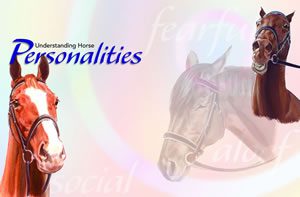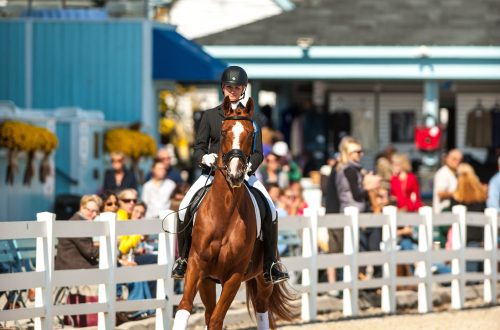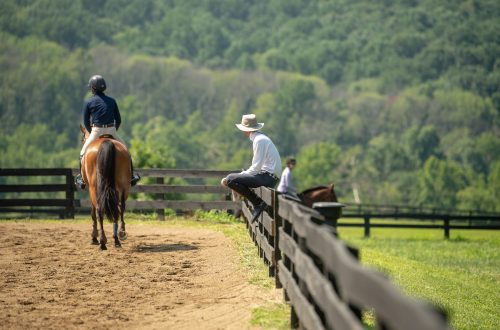
Horses and people: personality types and ways of interaction. Part 2. People
Horses and people: personality types and ways of interaction. Part 2. People
Continuation. Start – here.
Understanding your horse’s personality, combined with knowing your own temperament and skill level, will give you a better chance of success in your daily training and riding. The purpose of my articles is to share information that will help you better understand your horse, yourself and other riders with whom you interact.
In this article, we will talk about the personality types of people and how our characteristics can influence the selection and training of horses. We will also discuss examples of good and not so good combinations of human and horse personality types, and find out what to look for when choosing a trainer.
It would be great if we could better understand what makes each of us behave in a certain way – why do some people wait until they leave for the battlefield, while others get nervous only when they see a turn to the center line? Why can one rider accept and use the coach’s harsh criticism, while another “fails” because of such pressure? Why does a particular horse upset one rider and inspire another? The answers to these questions can be found by thinking about our innate personality type, which has a tangible impact on all aspects of our lives. How we manage our relationships, ride and train our horses is often driven by our individual and unique personality type. By knowing and understanding ourselves and other people, we can see a clearer picture of the world around us, understand who we are and why we think and act in certain ways.
Different personality types
Personality type theory was developed in the 1920s by Swiss psychiatrist Carl Jung and mother-daughter team Katherine Briggs and Isabelle Briggs-Myers. Since then, the Myers-Briggs Personality Type Test (MBTI) has become the most widely used and respected tool for facilitating communication between people.
Many of you, having read the previous article in the series, have thought about horse personality types. Now I will add information about the main eight possible preferences that make up the individual type of human personality. According to the MBTI, our personalities contain four different components. No type is more desirable than any other, as each has strengths and weaknesses. MBTI describes individuals in a four-letter abbreviation (eg ESTJ or INFP). Here’s what those letters mean:
E/I
Extrovert / Introvert (Extravert / Introvert). The first letter describes where we draw energy from: from people, actions, and events, as extroverts, or from thoughts, ideas, and concepts, as introverts. Extroverts often express their thoughts easily and clearly. They form thoughts in the process of speaking. Introverts need time to think about ideas before they talk about them. Being alone and quiet is hard for an extrovert. An introvert is a burden to excessive interaction, especially of a superficial nature or in large groups.
Applying this data to riding (training), it can be said that an extroverted coach and rider may feel frustrated after a lesson together, as they will have the feeling that they had to fight for “air time”. An introverted trainer and rider will walk away from their lesson with a feeling of understatement. When both trainees are aware of the differences between an extrovert and an introvert, the extrovert coach will know to give his introvert student the opportunity to speak up and voice concerns, perhaps even by asking him sharp questions. An introverted instructor will benefit from being aware that an extroverted student needs to talk more during the learning process., – so he will better understand and learn the information.
S/I
Touch / intuitive (Sensing / Intuition). The next letter describes how we learn. The sensory type receives information literally from all five senses, and understands best when the information is presented directly and realistically. Intuitives learn best when they first gain an understanding of concepts and general principles. They get bored with repetition or too much routine.
It is important for coaches and riders to know the difference between these types. Imagine the frustration of an intuitive rider taking lessons from a sensory coach who goes to great lengths to make his lessons clear, factual, and coherent. Both try, but at the end of the lesson, both are annoyed; The Intuitive Rider can’t focus, isn’t interested in learning so many details, and the Sensor Trainer can’t figure out why, no matter how many times he explains something, the Rider doesn’t “get it”!
The sensory coach needs to understand that when working with an intuitive rider, he needs to first explain the general concept of the lesson, entering only the necessary details and outlining the big picture. Only in this way can he succeed with the student and significantly speed up the learning process. This way, the sensor rider will benefit the most from a detailed lesson with clear and precise instructions. This will help him solve current problems and arouse interest in further learning.
T / F
Thinking / feeling (Thinking / Feeling). The next aspect of each person’s personality type involves how we make decisions. People of the thinking and feeling types make their decisions based on fundamentally different premises. Related conflicts are the main cause of resentment and misunderstanding.
People of the thinking type consider objective information in isolation and analytically, making logical conclusions. Representatives of the feeling type make decisions, evaluating how harmonious and “correct” they will be. Logic on the one hand and harmony on the other. But make no mistake, those who think feel and those who feel think!
Belonging to a thinking / feeling personality type also has a significant impact on the learning process. It is important that feeling types, whether children or adults, know that they are appreciated. Thinking riders, on the other hand, will learn best from someone they respect for their competence and skill.
As we develop and become more aware of ourselves as we grow older, it is extremely important that Thinking Types learn to appreciate and recognize their sometimes quite harsh and direct behavior towards Feeling Types and soften their tone as necessary. And it would be desirable for people of the feeling type to learn not to take everything so close to the heart.
Thoughtful dressage trainers must make special efforts to establish warm relations with their students and ensure that their instructions do not appear harsh or indifferent. Likewise, feeling-type instructors working with thinking-type riders must ensure that their teaching methods are trustworthy and respectful, that they are clear, consistent, and logical.
J/P
Decisive / perceiving (Judging / Perceiving). The final component of our personality type concerns how we organize the world around us. Those who need a sense of order and structure in their lives and want everything to be settled and resolved belong to the decisive type. They have a more rigid idea of time, they prefer to plan everything in advance, and therefore they rarely sin by being late and are not inclined to waste time. The decisive personality type is usually characterized by determination, and sometimes even stubbornness.
People who prefer to perceive are more fond of the process of collecting information, rather than the finished result. They tend to live “in the moment”, their view of the world is more flexible and open. Because they view time as a more elastic, infinite resource, planning ahead and making firm commitments is an unnecessary, if not unpleasant, task.
When the atmosphere and structure of the educational process is rather free and unstructured, it is the people of the perceiving type who are the least worried., since they seem to be able to “go with the flow”. And decisive people find this seeming disorganization distracting and unsettling. Hence, it is the decisive types who will be willing to keep their perceiving type counterparts focused on the task so that their more playful temperament does not get in the way of their ultimate goals. Receptive people, in turn, can help decisive people to ease and soften their sometimes too strict standards.
Although we can find traits of each of these eight types in ourselves, what really defines our particular type is the innate preferences that characterize behavior, such as the preference to use the right or left hand. It is the combination of our four types that provides the most complete and rich picture of our psychological portrait. Determining your personality type based on this brief overview would be difficult. Therefore, I recommend taking the MBTI online. It can make a difference in your life.
Ideally, as we get older, we begin to see the value of using our own opposing preferences. For example, decisive people can learn to relax the rules a little. Thinking types may find that not all decisions need to be logical in order to be correct. If a person is able to endure the slight discomfort of introspection and can explore new directions for growth, he will surely reap many benefits.
Personality type and riding
Our personality type also influences what kind of horse we buy, how we ride, how we work with it, and how our relationship develops with it. Of course, there are many factors that shape our personality and influence our interactions with horses – environment, education, intelligence, life experience, etc. But for each type there are many characteristics that affect our training style and compatibility with horses.
The following examples were made on the assumption that many of us ride and train horses mostly alone or with only occasional help from a trainer. Riders under the constant supervision of a competent trainer can moderate the natural tendencies of individual personality types that impede progress. For more independent riders, it would be wise to use their strengths to optimize their chances of a successful ride.
When choosing a horse, feeling types prefer to choose with their hearts rather than their brains. They tend to buy animals in need rather than the most suitable horse, believing that all a horse needs is love and affection. Of all the personality types, they have the least ability to critically evaluate a horse and are the most likely to emotionally attach themselves to it, whether it suits them or not.
When riding, feeling types may shy away from having to argue with a horse, often let her take the lead, and we all know where that leads. In addition, in their unwillingness to use a single stronger force (spur/whip) if necessary, they make the horse immune to the aids. However, feeling type riders have a better understanding of what the horse is “telling” them, and they are able to change the chosen plan if the horse on a particular day is not ready to follow it.
Thinking people have problems with self-confidence. They can take on a horse that is above their level, build a training program that they themselves are not ready for. They think they can handle everything. Perhaps very soon they will realize that they cannot jump above their heads. In their hasty decisions, they often do not show patience and do not wait for the necessary information in order to choose the most suitable course. However, people of the thinking type will suffer the inevitable setbacks and move on easily.
Sensory people will observe the horse’s actual performance, training and behavior, but may not see the potential or perspective, missing out on opportunities as a result. By focusing too much on one thing, they can jeopardize their success by becoming so engrossed in a particular learning problem that they lose the ability to see the solution. If a sensory person agrees that every failure in his training program will not inevitably lead to the complete collapse of all his plans, this will help him get back on track. Because sensory riders tend to follow directions and lesson plans, their progress can be more consistent.
Intuitives, with their ability to see “what could be” better than “what is now,” can ignore the obvious and real problems that a particular combination of horse and rider can bring. Their natural idealism, combined with their desire to focus on the big picture rather than the details, can make their choice impractical. But because of their optimism, intuitives (especially the intuitive/feeling type) can be quite adept at convincing themselves that their horses are performing much better than they really are.
Identifying your individual personality type will help you make better use of your strengths and overcome your weaknesses.
My type is ISFJ (Introvert-Sensing-Feeling-Judging). I don’t like daily conflicts. And since I ride mostly on my own, picking a hard type horse is out of the question. As an introvert, I don’t need a social horse and would rather work with an aloof horse. But I chose a passive socially/aloof horse, which turned out to be for me. ideal. He gets along well with people, and I love the manifestations of his social type.
Watching some dressage masters, you understand that it would take you more than one lifetime to reach their level. But, as a rider or trainer, you could speed up the process considerably by focusing more on the strengths and blind spots of your individual type. If we add here an understanding of the type of horse, we have another invaluable tool to help us move further along the endless path of dressage.
Personality types and training
Search for “your” instructor
Knowing what type of personality a person belongs to, we can understand his behavior and improve communication with him. Dressage then becomes an art when communication between man and horse is at the proper level. When your workouts work for you, it means that you have achieved success in communication with your coach, communicate fruitfully with him, solving problems and problems. Someone, based on their individual preferences, enjoys lessons that are conducted in an entertaining manner, someone needs sympathy, for someone only the information received is valuable. A good instructor must understand what method of teaching should be chosen so that his student gets the most out of training.
When evaluating a new student who wants to train with our team (myself, my husband Kim and daughter Cassie), we ask them to take the MBTI test to see if they are E or I (Extrovert or Introvert), S or N (Sensor or Intuitive). ), T or F (thinking or feeling), and J or P (deciding or perceiving). This will help us to make subsequent training sessions as complete as possible.
Kim is an ISTJ, which means that he is usually calm and likes to organize, think, and plan. I am an ENTJ – self-confident, very independent, strong-willed and open. I’m sure you can guess how our different personality types affect our individual learning and communication styles. Even though we both teach the same thing, our approaches, our formulations, and even our expectations can be very different. Thus, we have found it useful to study both our learning styles and those of our students. We classify students based on their previous experience, individual needs and goals, and whether they are S (learn better when detailed) or N (learn better when they get pictures from general concepts). Beginning S riders usually start training with Kim. New or beginner N-riders – with me. We find this helpful as our different communication and learning styles allow students of different personality types to find what suits them.
Later, when the student has developed some basic skills, we often change the course of things, and he begins to receive information in a slightly different way.
We have an ESTJ student, Beth, who started with Kim and stayed with him from Prep to FEI level. From time to time I give her a few lessons to help her see the “big picture” before the rides.
Combination of rider and horse
As professional trainers, Kim and I must be able to handle any horse, regardless of his or our personality type. If you are still working on your confident seat and communication skills, you might be better off choosing horses with fairly passive traits. There are exceptions, of course, but the social/aloof or passive/social/aloof type is more likely to suit you. Find the horse that will give you the most comfortable experience on your training path.
I have an amateur INTJ student, Lucinda, who owns and works with a difficult Swedish half-breed gelding named Jack. On a passive/aggressive scale, he can be rated at 5 points – a talented horse that loves to argue and assert itself. Lucinda gets one or two lessons a week, so she has the lion’s share of the responsibility for the horse’s progress. She prefers everything to be harmonious and dislikes the very essence of confrontation, but she understands that she must maintain her place as a leader and insist on getting answers to her messages without getting stuck in the argument that Jack so often tries to initiate.
Luckily, Lucinda is not overly emotional about her riding and can see that Jack understands the practical approach best. Whenever she introduces him to a new move or signal sequence, Jack tries to establish himself by dodging, falling on his arm, or resisting the leg. From time to time I sit down and give clear, and sometimes more severe prompts to make sure that our requests are clear to him.
When Lucinda sees that Jack can get the job done, but she needs to change her approach, and not insist on the old one, arguing with the horse, she is sure to change it. If she got stuck in Jack’s trap, she would probably stop at the third level, because this work is easier for the horse, he would stop resisting. However, the pair are now working on all FEI movements and plan to ride the Small Prix next year.
Agatha (ENFJ), one of our student volunteers, became attached to a mare that, at first glance, seemed unsuitable for her. Caroline, an 8-year-old skittish/difficult type mare, scores 7 on the passive/aggressive scale. Agatha is a balanced rider and not shy, but she has never ridden a horse like Caroline, energetic and challenging. Caroline seems to need constant reassurance, but because she’s also complicated, this strategy doesn’t work. Agatha learned to be patient but firm and ride with clear signals that would remain consistent from lesson to lesson. The mare responded too unpredictably and sometimes quite hostilely to the aids to be a reliable dressage horse. Any rider with Agatha’s skills might have struggled and become frustrated in such a situation, but when the mare really obeyed, she looked beautiful, and that was all that motivated and inspired Agatha, and she continued to work. Kim and I oversee this “project” and often mount the mare ourselves to make sure that there are no problems with the timely application of the controls and their sufficiency. The mare is an example of a type of horse that can be frustrating or even dangerous, but now we have a program to keep her progressing for the better.
Competition Strategies
A good trainer has every chance of succeeding with any combination of personality types in a pair of horse and rider. When we come to a tournament with our rather large group, the first task is to make sure the horses are comfortable in the new environment, we also need to make sure that the horses will work in the new place according to home standards.
Some horses need to calm down and familiarize themselves with everything before they relax and start working. Some, especially young stallions, can be very agitated and want to communicate or show off first of all (only after that they are able to focus on the tasks at hand). Our goal is to notice these nuances and take them into account in the warm-up strategy.
Riders are not so different from horses. Some need to be constantly monitored and reassured, because they themselves are not confident in themselves. Someone needs encouragement and conversations, and someone just needs practical advice. We have found that our introverted (I) students who are also F (feeling) tend to wait until they feel really prepared and confident before settling into the tournament atmosphere. In contrast, extraverted (E) T- or P-students may start before they are fully prepared.
Kim and I have also observed over the years that S riders tend to be more practical about their individual strengths and weaknesses than their N riders.
We have also seen many times that N riders tend to be paired too long with the wrong horse because they think their skills are growing faster than they really are.
As an N rider and coach, I am often guilty of telling a rider that we can handle his horse because I think I can handle it. However, as time went on it became apparent that although I could successfully work on a particular horse, could articulate advice on how to “ride”, I often pushed my riders out of their comfort zones by making them do what they wanted to do. were not ready. I realized that in most cases it is better for riders to stay within their comfort zones. This means that while we should consult professionals, we should also be mindful of our own instincts.
Yvonne Barto. Transfer Valeria Smirnova based on site materials https://dressagetoday.com





